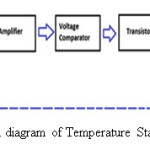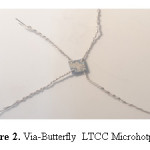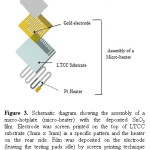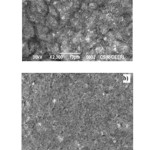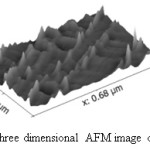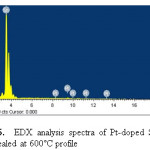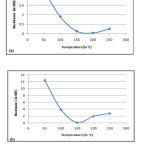Kritika Bhattacharya1*  ,Shruti Kapoor1 and Nikhil Suri2
,Shruti Kapoor1 and Nikhil Suri2
1 Centre for Nanoscience and Nanotechnology, Jamia Millia Islamia, New Delhi -110025, India
2Hybrid Microcircuit Group, CSIR-CEERI, Pilani-333031, India
Corresponding author Email: kritikabhattacharya19@gmail.com
DOI : http://dx.doi.org/10.13005/msri/140212
Article Publishing History
Article Received on : 21 Sept 2017
Article Accepted on : 04 Oct 2017
Article Published : 02 Nov 2017
Plagiarism Check: Yes
Article Metrics
ABSTRACT:
An optimized platinum (Pt) doped tin oxide (SnO2) ink was prepared by chemical route and was deposited on low temperature co-fired ceramics (LTCC) micro-hotplate by screen printing. An alkoxide ink was prepared by mixing tin(II) 2-ethylexanoate (17 wt%) with isopropanol (27 wt%) and SnO2 powder (55 wt%). Doping of the ink was done using Pt (1 wt%) which increased the resistance of SnO2 film at room temperature and also reduced the operating temperature. The temperature of ensor was obtained and stabilised using MOSFET based temperature stability circuit. Film characterization was performed using Atomic Force Microscopy (AFM), Scanning Electron Microscopy (SEM) and Energy Dispersive X-ray Spectroscopy (EDS) technique. Small grain size and high porosity is the requirement for good sensing. The grain size was found to be in the range of 150-180 nm and the film was sufficiently porous. Resistance change of the film was also investigated in the presence of carbon monoxide (CO) to assure gas sensing.
KEYWORDS:
Carbon monoxide; Gas sensing; LTCC; Screen printing; Tin Oxide
Copy the following to cite this article:
Bhattacharya K, Kapoor S, Suri N. An Optimized Platinum (Pt) Doped Tin-oxide(SnO2) Ink for Deposition of Gas Sensing Thick Film on LTCC Micro-hotplate. Mat.Sci.Res.India;14(2)
|
Copy the following to cite this URL:
Bhattacharya K, Kapoor S, Suri N. An Optimized Platinum (Pt) Doped Tin-oxide(SnO2) Ink for Deposition of Gas Sensing Thick Film on LTCC Micro-hotplate. Mat.Sci.Res.India;14(2). Available from: http://www.materialsciencejournal.org/?p=6157
|
Introduction
Elevated atmospheric pollution has raised the demand for effective and inexpensive system for detection and quantification of environmentally hazardous gases. The detecting systems available in market are mostly based on optical spectroscopy and gas chromatography which are both expensive and time consuming analytical techniques. Gas sensors are promising alternatives for environmental measurements and those based on metal oxide semiconductors (MOS) are extensively used because of their low cost, high sensitivity, wide range target selectivity, short response time and long life.1 Sensing mechanism of these sensors is based on the redox reactions taking place at the grain boundaries of the film. MOS based gas sensor materials, typically n-type semiconductors form an electron depleted surface layer under normal atmospheric conditions and a typical temperature range of 300-600°C. At such a high temperature, the atmospheric oxygen adsorb on the surface and take out electrons from the film surface forming O¯ and O2¯ species. Reducing gases (like CO, H2) and oxidizing gases (like NO2) react with the species and attune the depletion layer thickness leading to accountable change in the resistance of the material.2 Among all the sensors based on metal oxide semiconductors, the sensitivity of SnO2-based sensor is relatively high, leading to its greater popularity.3
LTCC is a special material system manufactured by using green sheets made up of 40% filler (ceramics mainly alumina), 45% glass (SiO2) and 15% organic vehicle and produced by tape casting.4 LTCC technology ease the preparation of miniature integrated packages and devices for various sensor and actuator applications.5 Gas sensors manufactured in LTCC technology show high temperature stability, possibility of integration and inexpensive manufacturing. LTCC can form small compact sensors with low power consumption due to their low thermal conductivity compared to standard devices on alumina. Optimum design of micro-hotplate can reduce power consumption significantly.6
Conventional SnO2 inks consist of glass as binder which decreases the conductivity of the film.7,8 J.P. Viricelle et al. proposed a solution for the problem by developing a new ink which had no glass and was developed by adding SnO2 powder to tin oxide gel. Due to less adhesion and more complexity in preparation of the ink, another ink was prepared with tin alkoxide. Platinum(Pt) doping can promote sensor response to CO gas. During thermal treatment, more oxygen molecules gets adsorbed onto the SnO2 film surface when doped with Pt as it forms the adsorption site for dissociation of O2 to O¯ and O2¯ species.9 This attracts more CO towards the oxygen species and release CO2, thus increasing the sensitivity with faster response time. Pt also lowers the operating temperature required for sensing CO.10 So, investigations presented in this paper concern with the addition of Pt to the tin alkoxide ink.
Experimental Details
Temperature Stability Circuit
Sensitivity of a gas sensor depends on the working temperature, which can be realised using a hot-plate. High reaction temperature of O¯ demands high operating temperature for MOS based gas sensors. The sensitive layer has to be preheated to an elevated temperature so as to increase the probability of gas molecule adsorption and promote the consumption of ions of the sensing material. With the consumption of ions, sensing film conductivity increases realizing the sensing function. To maintain the sensing film at a desired temperature, temperature stability circuit was simulated in PROTEUS 8 professional and designed on LTCC substrate. Block diagram is shown in figure 1.
Figure 1: Block diagram of Temperature Stability circuit
Fabrication of Micro-Hotplate
For an optimized gas sensor design, low power consumption and lower heat losses due to conduction, convection and radiation by the heater is required.2 Heater shape and size should be such that the heat is uniformly distributed and less power is consumed. These days micro-hotplates are designed for the heating of the sensing film on it. LTCC having low thermal conductivity, is appropriate for low heat loss micro-hotplate. LTCC micro-hotplate as shown in figure 3, was designed having size 3mm x 3mm consisting 3 layers of fired green tapes with top side printed with gold electrode in a specific design (via-butterfly as shown in figure 2) and the rear side printed with platinum as heater. Sensing film was deposited on the top of electrodes. It was operated between the temperature range of 25-250°C. Maximum operating temperature was 450°C. At around 3V, it produced a temperature of 250°C with power consumption of 1W. This design of LTCC micro-hotplate had power consumption less than thick film micro-hotplate (~2.5 W) but more than Si micro-hotplate (~0.02W) in line with the data given in.12
Development of Ink
Tin(II) 2-ethylexanoate was used to develop the tin alkoxide ink due to its advantage of not producing impurities like Cl, Na, etc. which tends to modify the conductivity of the film.7 Isopropanol (27 wt%) was added to tin(II) 2-ethylexanoate (17 wt%) and was stirred. After sometime, SnO2 powder (55 wt%) was added and the stirring was continued. After 2 hrs, the developed alkoxide ink was doped with Pt (1wt%) and again stirred for 1 hr. All SnO2 granules of the powder were crushed and well-mixed. The ink was sufficiently viscous suitable for screen printing.
Figure 2: Via-Butterfly LTCC Microhotplate
Ink Deposition
Screen-printing technology was used to deposit the ink on LTCC micro-hotplate because of its low cost of production and efficient deposition, enabling to deposit sensing elements for gas sensors, mainly on ceramics. Using computer aided screen printing, micro fabrication is possible with good resolution.
The ink was deposited using 200 mesh mask. After deposition the film was kept at room temperature for 20-30 min so that it stabilizes. Then it was dried at 150°C for 30 min and then annealing was done at 600°C profile for approximately 2hrs under ambient air.
Figure 3: Schematic diagram showing the assembly of a micro-hotplate (micro-heater) with the deposited SnO2 film. Electrode was screen printed on the top of LTCC substrate (3mm x 3mm) in a specific pattern and the heater on the rear side. Film was deposited on the electrode (leaving the testing pads idle) by screen printing technique (using 200 mesh mask suitably covered to get the desired layout of the film).
Results and Discussion
Film Characterization
Surface morphology of the film was studied by SEM. Figure 4(b) shows the SEM micrograph of the deposited film. Figure 4(a) is the zoomed SEM image of the film to visualize the grain size and porosity. The grain size was found to be in the range of 150-180 nm. Thickness of the film was measured using Stylus profiler DEKTAK 6M and was found to be around 39 µm.
The Minus K Technology system by Digital Instruments was employed for the AFM experiments. The tapping mode was used for the morphology characterization so as to protect the AFM tip from the rough surface of the film. The three dimensional AFM image of SnO2 film shown in figure 5 has a measured surface roughness of (Area Ra 1.94 nm) and (Area RMS 2.75 nm) which shows well separated slightly conical nano columner structure and reveals that the film was sufficiently porous with large surface area.
Figure 4: SEM micrograph of the deposited film
Figure 5: Three dimensional AFM image of SnO2 film.
EDX analysis was done to confirm-
- Composition of screen printed film
- Atomic and wt% of deposited material
It is an approximate analysis which showed the presence of Sn and O and small amount of Pt. Figure 6 illustrates that no other impurity elements were found (also shown in table 1).
Figure 6: EDX analysis spectra of Pt-doped SnO2 thickfilm annealed at 600°C profile
Table 1: Quantitative elemental analysis
|
Sample-SnO2
|
Weight %
|
Atomic%
|
|
O K
|
37.71
|
68.28
|
|
Sn L
|
60.94
|
31.45
|
|
Pt L
|
1.35
|
0.27
|
|
Total
|
100
|
100
|
Electrical Characterization
Figure 7 shows the variation in resistance of the deposited film with temperature in presence of 50 ppm CO gas. At room temperature no significant drop was noticed. As the film was heated in CO atmosphere, the resistance started falling considerably. The film on exposure to CO shows more fall of resistance than the film not exposed to CO. This may be due to the fact that on heating a semiconductor film, electrons generated are taken up by ambient oxygen and only a few are left for conduction where as heating the film in CO atmosphere releases those taken up electrons by oxygen, thus increasing the electron concentration and reducing the resistance significantly. Above a critical temperature, the resistance of the film exposed to CO gas started increasing which may be due to the fact that the added desorption due to the target gases is small relative to the steady-state desorption in air.11
On comparing films deposited using alkoxide ink and alkoxide ink with Pt-doping at room temperature, increased resistance was found in the later. Moreover, Pt reduced the operating temperature, because it acts as a catalyst speeding up the adsorption of oxygen and dissociation into oxygen species, which leads to more CO interaction with the species, thereby reducing the operating temperature to detect the same concentration of CO.
Figure 7: Variation of resistance with temperature in 50ppm CO gas of (a) alkoxide ink film (b) alkoxide ink with Pt doping film
Conclusions
It was found that the film developed and printed on LTCC had good adhesion and showed high sensitivity under low operating temperature due to the presence of Pt compared to conventional inks. This paper also attests to the fact that LTCC can become a major substrate for gas sensors in coming years over alumina because it can produce gas sensor in an integrated package in a small area with minimal power consumption, if properly exploited. Development of the film material using different concentrations of alkoxide ink, Pt doping and use of SnO2 nano powder in place of SnO2 powder can be further investigated.
Acknowledgements
We sincerely pay our gratitude to the Hybrid Microcircuit Group, CSIR-CEERI, Pilani for helping us in completing our project. The authors wish to thank Mr. Bhawani Shankar for technical assistance during measurements.
References
- Wetchakun K., Samerjai T., Tamaekong N., Liewhiran C., Siriwong C., Kruefu V., Wisitsoraat A., Tuantranont A., Phanichphant S. Semiconducting metal oxides as sensors for environmentally hazardous gases. Sensors and Actuators. 2011;60:580–591.
CrossRef
- Sharma S., Madou M. A new approach to gas sensing with nanotechnology. Phil. Trans. R. Soc. 2011;370:2448–2473. doi:10. 1098/rsta. 0506.
- Liu X., Cheng S., Liu H., Hu S.,Zhang D., Ning H. A Survey on Gas Sensing Technology. Sensors. 2012;12:9635-9665.
CrossRef
- Birol H., White Paper ―Technical & Financial Value Generation through Ceramic Substrates in Electronics Industry. CSEM Brasil. 2000.
- Patel C., Jadhav A., Lone S., Rane V., Chaware V., Giramkar V.,Phatak G. Miniaturization of LTCC based hot plates for Gas sensors Application, International Symposium on Physics and Technology of sensors. 2012;7-10. March 2012.
- Kita J., Rettig F.,Moos R., Drüe H. K,Thust H. Hot Plate Gas Sensors- Are Ceramics Better? International Journal of Applied Ceramic Technology. 2005;2(5):383-389.
CrossRef
- Riviere B.,Viricelle J. P., Pijolat C. Development of tin oxide material by screen-printing technology for micro-machined gas sensors. Sensors and Actuators. 2003;3:531–537.
CrossRef
- Viricelle J. P.,Riviere B., Pijolat C. Optimization of SnO2 screen-printing inks for gas sensor applications. Journal of the European Ceramic Society. 2005;25:2137–2140.
CrossRef
- Göpel W et al., SnO2 Sensors current status and future prospects. Sensors and Actuators. 1995;6-27:1-12.
- Esfandyarpour B., Mohajerzadeh S., Famini S., Khodadadi A.,Soleimani A. E. High sensitivity Pt-doped SnO2 gas sensors fabricated using sol–gel solution on micromachined (1 0 0) Si substrates. Sensors and Actuators. 2004;00:190–194.
CrossRef
- Tripathy K. S., Hota P. B. Carbon Monoxide Sensitivity of Tin Oxide Thin Film Synthesized by Sol Gel Method. The African Review of Physics. 2012;7:0047.
- Jain Y. K., Khanna V. K. Thick Film, LTCC or Silicon Microhotplate for Gas Sensor and Other Applications. International Workshop on Physics of Semiconductor Devices. 2007;16-20.

This work is licensed under a Creative Commons Attribution 4.0 International License.
 ,Shruti Kapoor1 and Nikhil Suri2
,Shruti Kapoor1 and Nikhil Suri2 Material Science Research India An International Peer Reviewed Research Journal
Material Science Research India An International Peer Reviewed Research Journal

